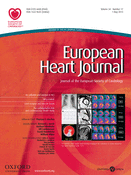Eur Heart J:睡眠剥夺增高血压风险
2013-06-19 高晓方 译 医学论坛网
法国一项研究表明,在健康老年受试者中,睡眠期间的反复交感性觉醒与收缩压和高血压风险升高相关;交感神经过度兴奋可能为潜在机制。论文于6月11日在线发表于《欧洲心脏杂志》(Eur Heart J)。 此项研究共纳入780例平均年龄为68.7岁的健康受试者(女性57.4%)。受试者均无睡眠障碍性呼吸、冠心病和神经性疾病,并接受了生理记录仪、24小时动态心电图和24小时动态血
法国一项研究表明,在健康老年受试者中,睡眠期间的反复交感性觉醒与收缩压和高血压风险升高相关;交感神经过度兴奋可能为潜在机制。论文于6月11日在线发表于《欧洲心脏杂志》(Eur Heart J)。
此项研究共纳入780例平均年龄为68.7岁的健康受试者(女性57.4%)。受试者均无睡眠障碍性呼吸、冠心病和神经性疾病,并接受了生理记录仪、24小时动态心电图和24小时动态血压检查。以自动觉醒指数(AAI)代表睡眠剥夺。采用多变量回归分析评估相关性。
结果显示,睡眠剥夺与日间和24小时收缩压升高以及24小时收缩期高血压风险升高相关,并且独立于睡眠障碍性呼吸、体重指数、性别、糖尿病、高胆固醇血症以及自报睡眠持续时间和质量等混淆因素。AAI升高与日间和夜间低频功率以及低-高频比具有相关性,提示日间和夜间交感神经过度兴奋。

Sympathetic overactivity due to sleep fragmentation is associated with elevated diurnal systolic blood pressure in healthy elderly subjects: the PROOF-SYNAPSE study.
AIMS
Sleep fragmentation is a landmark of sleep disorders, because microarousals are systematically associated with sympathetic surges (i.e. sympathetic arousals). However, the impact of sympathetic sleep fragmentation on blood pressure (BP) remains understudied. We assessed the relationships between 24 h ambulatory BP monitoring, the autonomic arousal index (AAI) derived from pulse transit time, and heart rate variability indices. We hypothesized that repeated sympathetic arousals during sleep are associated with elevated BP in a large population of elderly volunteers.
METHODS AND RESULTS
Volunteer subjects (n = 780, 57.4% women) with a mean age of 68.7 years and free of known sleep-disordered breathing, coronary heart diseases, and neurological disorders underwent polygraphy, 24 h ECG Holter monitoring, and 24 h ambulatory BP monitoring. Multivariate regressions showed that sleep fragmentation, expressed by AAI, was associated with elevated diurnal (P = 0.008) and 24 h (P = 0.005) systolic BP and higher risk for 24 h [odds ratio (OR): 1.70 (1.04-2.80), P = 0.036] systolic hypertension, independently of confounders such as sleep-disordered breathing, body mass index, sex, diabetes, hypercholesterolaemia, and self-reported sleep duration and quality. Increased AAI was associated with higher nocturnal and diurnal low-frequency power (P < 0.001) and low-to-high-frequency ratio (P < 0.001), suggesting nocturnal and diurnal sympathetic overactivity.
CONCLUSION
In healthy elderly subjects, repetitive sympathetic arousals during sleep are associated with elevated systolic BP and higher risk of hypertension, after controlling for confounders. Sympathetic overactivity is the proposed underlying mechanism.
本网站所有内容来源注明为“梅斯医学”或“MedSci原创”的文字、图片和音视频资料,版权均属于梅斯医学所有。非经授权,任何媒体、网站或个人不得转载,授权转载时须注明来源为“梅斯医学”。其它来源的文章系转载文章,或“梅斯号”自媒体发布的文章,仅系出于传递更多信息之目的,本站仅负责审核内容合规,其内容不代表本站立场,本站不负责内容的准确性和版权。如果存在侵权、或不希望被转载的媒体或个人可与我们联系,我们将立即进行删除处理。
在此留言








#ART#
62
#增高#
63
#HEART#
69
#增高#
83
#睡眠剥夺#
66